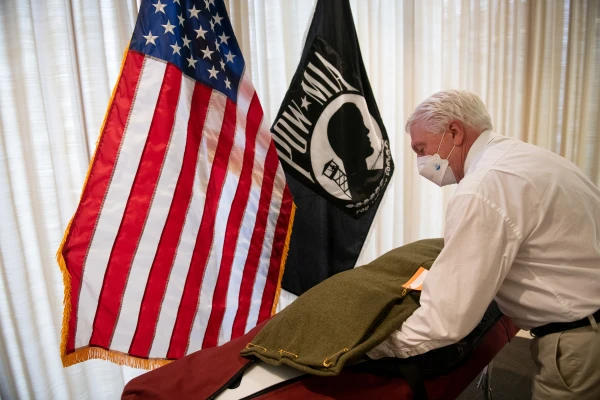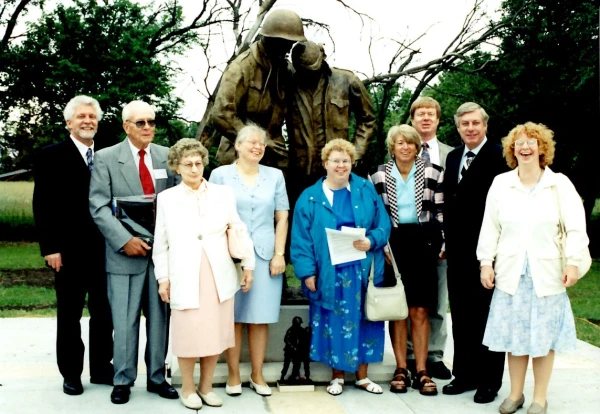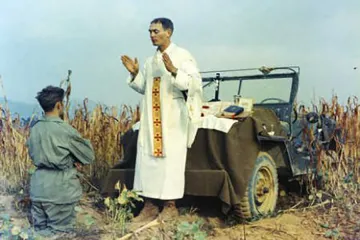CNA Staff, Nov 11, 2024 / 06:00 am
As a new film about U.S. military chaplains was released in theaters on Nov. 8, the nephew of heroic priest and chaplain Servant of God Father Emil Kapaun spoke about his uncle’s virtue and sense of mission during the Korean War.
“Fighting Spirit: A Combat Chaplain’s Journey” tells the story of former Army chaplain Justin Roberts as he travels to the funeral of Kapaun. Along the way, Roberts is inspired by the lives of the 419 other U.S. military chaplains who have given their lives in service. The documentary explores the stories of several of these chaplains, including the beloved Catholic priest.
Kapaun was a priest of the Diocese of Wichita, Kansas. Ordained on June 9, 1940, he began training in the U.S. Army Chaplain School at Fort Devens four years after his ordination. In January 1950, he was sent to Japan as a chaplain in the 8th Cavalry Regiment, 1st Cavalry Division. In July 1950, he was then sent to Korea, where he brought the sacraments to troops, tended to the injured, and prayed with soldiers in the foxholes. At times he celebrated Mass on the battlefield using the hood of a jeep as a makeshift altar.

During the Battle of Unsan, Kapaun was captured along with other soldiers and taken to a Chinese-run prison camp in Pyoktong, North Korea. While there, he regularly stole food for his fellow prisoners and tended to their spiritual needs despite a prohibition on prayer.
After being taken to what prisoners called the “death house,” Kapaun died on May 23, 1951, after months of malnutrition and pneumonia.
His cause for sainthood is being promoted by the Diocese of Wichita and is currently being reviewed by the theological committee for the Dicastery for the Causes of Saints in Rome.
A nephew of the heroic priest, Ray Kapaun, told CNA that growing up he heard stories about his uncle from his grandmother. He recalled hearing about his uncle’s devotion to the Blessed Virgin Mary and how his vocation to the priesthood was clear from a young age: He would stack cardboard boxes on top of one another, throw a towel over them, and pretend to say Mass at his makeshift altar.
“He was the most unselfish person I think I’ve ever heard of,” Ray Kapaun said. “He just always put everybody else ahead of his own needs.”
One story that Ray remembers was told to him by his father. Shortly before Father Kapaun was about to head out to the Korean War, he went to visit his family in his hometown of Pilsen, Kansas. He pulled Ray’s father aside and told him: “I don’t think I’m going to be coming back from this one.”
“Dad was like, ‘No, don’t talk like that. You can’t,’” Ray recalled. “And he said, ‘I’m not telling you that to make you sad or feel sorry for me,’ he said, ‘I just have that feeling that I’m not coming back from this one.’”
Ray believes it was this feeling that allowed his uncle to “do the things he did to help the guys in the prison camp, to run out across the battlefield when bombs were exploding — he knew that is exactly where he needed to be and he did it with compassion, but he didn’t do it with fear. He did it with a knowing that God was going to take care of him and that was exactly where he needed to be.”
In March 2021, after 70 years, the skeletal remains of Father Kapaun were identified among 866 other unknown Korean soldiers buried at the National Memorial Cemetery of the Pacific in Honolulu. These remains were handed to American forces in 1954 by North Korea.
Ray said receiving the call that his uncle’s remains had been found was something he “never ever envisioned.” He called it truly “miraculous” that when Father Kapaun’s casket was opened for his body to be identified, “his [skeletal] remains were 98% intact.”
“They actually sent us a photo of the remains laid out as the skeleton and he was just missing a couple of fingertips, one of his toes, and the kneecap was all he was missing. So that in and of itself was pretty much a miracle” he said.
Father Kapaun’s funeral Mass was held on Sept. 29, 2021, at Wichita’s Hartman Arena, where over 5,000 people came together to remember him.
(Story continues below)

In the days leading up to the funeral, Ray and his wife hosted two of the POWs (prisoners of war) who spent time with Father Kapaun in the prison camp and are the last two still alive.
Ray shared “an incredible moment” with the POWs: They were taken to the mortuary to have a moment alone with Father Kapaun and before entering, one of them, Col. Michael Dowe, turned to Ray and asked: “Am I going to get the chance to hold Father in my arms just one last time?”
“So, we had opened up the casket, and Mike is there, and he just starts crying and he was talking to Father and he’s like, ‘When they came to take you away we just didn’t stand up enough for you, we just didn’t stand up enough,’” Ray recalled.
“I know Father had his hands on his shoulders then as he did in the camp and I know he told him, ‘Oh, it’s OK Mike. You just gotta let me go. I’m where I wanted to be. So it’s OK,’” Ray said. “Those moments were probably the most memorable, the most touching for me.”
When asked how Father Kapaun can be a source of inspiration for not only chaplains but also for everyone, Ray said: “Father gives hope, and Father gives a meaning to find the right in the world, Father always looked for the good in the world.”
“I think especially now with all the division and all the hate and all the things going on in this world, he only saw the person. It wasn’t that you needed to be Catholic; he saw the person, he saw what their soul was and how they treated others.”
He added: “He saw the compassion that was needed, he saw somebody needed help and he would help them at whatever sacrifice to his own health.”
As for what he hopes people will take away from the new film about his uncle, Ray said he hopes people would “see others and not judge others” and that “you don’t have to do anything grandiose to do kind and great things in this world.”





